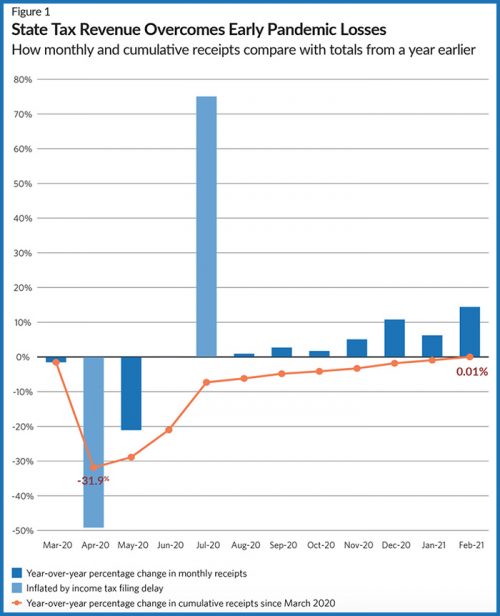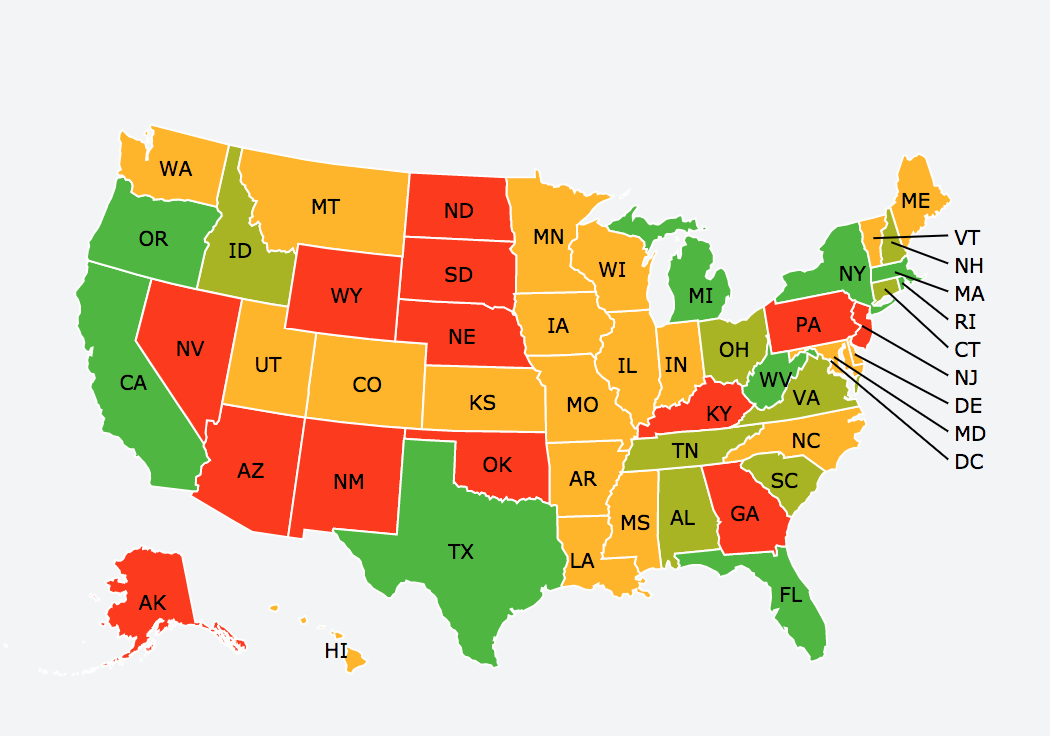The Week in COVID & Education Policy: UK Schools Struggle with Variants, State Budgets Recover and More Key Updates

This is our weekly briefing on how the pandemic is shaping schools and education policy, vetted, as always, by AEI Visiting Fellow John Bailey. Click here to see the full archive. Get this weekly roundup, as well as rolling daily updates, delivered straight to your inbox — sign up for The 74 Newsletter.
COVID-19 School Data Hub: Emily Oster announced a new national database to inform policy and research about the COVID-19 pandemic and students in U.S. public schools
- “Our goal is to compile data at either the school or district level on learning models (traditional five-day-in-person, hybrid, virtual) over the course of the school year. We will additionally aim to collect information on enrollment counts by learning model.”
- “When we launch the full site in August, these data (and, we hope, much more) will be available for download. We’ll also be working to post public data that can be matched up to the school data — information like school demographics and community COVID cases, and possibly also information about things like internet connectivity infrastructure.”
- “We’ll also be working with private companies to post information about their data, and to connect them with researchers and policymakers who might want to access information on learning outcomes, child health or school attendance data.”
June 11, 2021 — The Big Three
Schools in England struggle to contain rising COVID-19 variants. Students, who remain unvaccinated, have been disproportionately hit.
- “The proportion of pupils in England absent from school because of COVID nearly doubled in the week leading up to the start of half-term, rising from 1 percent to 1.8, and accounting for more than 140,000 pupils, according to government data.”
- “In places where the Delta variant first identified in India has taken hold, the spike is sharpest.”
- “Professor Russell Viner, a pediatric professor at University College London and adviser to government’s SAGE committee, said high levels of testing in schools meant more cases were being recorded than other parts of society, adding that school infections mirrored those in the community, rather than driving rates of transmission.”

States Rebound from Bleak Budget Forecasts, the Associated Press reports
- “It’s definitely safe to say that states are in a much better fiscal situation than they anticipated,” said Erica MacKellar, a fiscal analyst with National Conference of State Legislatures.
- “Spending plans for the budget year that begins July 1 are up 10 percent or more in states spanning from Florida and Maryland to Colorado, Utah and Washington.”
- “A recent Pew report found that after an initial sharp plunge in tax revenue, 29 states recovered to take in as much or more during the peak pandemic period of March 2020 through February 2021 than they did during the same 12 months before the pandemic began.”
- “Lawmakers in Maryland used words like ‘stunning’ and ‘unique’ to describe how federal aid helped reshape their budget situation. The state’s record $52.4 billion budget for its new fiscal year provides bonuses to state workers, boosts payments to the poor, builds parks and playgrounds in every county, and still sets aside about $2 billion for savings.”
How Can Education Use the Approach that Accelerated COVID Vaccine Development? Via Stacey Childress
- “Advances in instructional methods and technologies have shown promise at small scale. But the education sector struggles to translate these into more widely used methods, tools and practices that support students and teachers.”
- “R&D converts research into capabilities — practices, methods, prototypes, tools — that can be built on to create breakthroughs. The education sector, and K-12 in particular, lacks this type of R&D capacity. Other sectors of society have much stronger R&D ecosystems, and often the innovations they spur have enormous impact on our everyday lives.”
- “Arati Prabhaker, who served as DARPA’s [Defense Advanced Research Projects Agency] director during the second Obama administration, made the connection in an op-ed in The Hill last week: ‘Developing a vaccine for a new infectious agent used to take years or decades. Moderna was able to ship its first COVID-19 vaccine doses for clinical trials just 42 days after the sequence for the spike protein was known. A DARPA program made that possible.’”
Federal Updates
Centers for Disease Control and Prevention: Fully vaccinated higher-education campuses can mostly drop coronavirus safety measures.
- “Campuses without entirely vaccinated populations should use prevention strategies, such as mask-wearing and physical distancing.”
Education Department: Released COVID-19 Handbook Volume 3: Strategies for Safe Operation and Addressing the Impact of COVID-19 on Higher Education Students, Faculty and Staff.
Child Tax Credit: Treasury is sending letters to more than 36 million families who may qualify for monthly payments. The IRS said it will receive a second letter that will estimate their monthly payment amount, which will begin hitting bank accounts July 15.
National Telecommunications and Information Administration: Launched the $1 billion tribal connectivity grant program. Applications are due Sept. 1.
City & State News
California: Releases new summer programming and school reopening data, launches Parental Engagement Campaign
Florida: Tampa Bay schools never saw big coronavirus outbreaks this year. Why? Some say pandemic protocols protected students and teachers. Others say the threat was always exaggerated.
Michigan: Gov. Gretchen Whitmer vetoes bill to exempt graduations from crowd limits.
Minnesota: Heat causes 15 Minneapolis public schools to move to distance learning.
New Mexico: When Albuquerque Public Schools offered free online classes this summer, some 5,600 students signed up, outstripping the supply and forcing the district to close enrollment on Friday.
- “The district estimates that about 43 percent of students — a total of 16,810 students — failed at least one course in the fall 2020 semester.”
COVID-19 Research
Pfizer: Will start a large study to test COVID-19 vaccine in children under 12. The study will enroll up to 4,500 children at more than 90 clinical sites in the U.S., Finland, Poland and Spain.
Moderna: CEO expects COVID-19 vaccine to be available for kids as young as 5 by early fall.
Teen Vaccinations: A lag in COVID-19 vaccinations among adolescents could delay U.S. return to normalcy.
School Vaccination Sites: COVID Collaborative and the Council of the Great City Schools are supporting districts in a school-level vaccination effort. The Association of State and Territorial Health Officials put together a comprehensive guide for standing up vaccination clinics in schools.
Virologic Features of SARS-CoV-2 Infection in Children: A new study showed that “age is not a predictor of viral infection dynamics, and that children of all ages can have high SARS-CoV-2 viral loads.”
COVID-19 Vaccine Distribution: Helpful data visualization tool from McKinsey.
Viewpoints
Five Pandemic-era Education Practices that Deserve to Be Dumped in the Dustbin: From Michael Petrilli at EdNext
- Roomies and Zoomies simultaneously
- Waiving seat-time requirements
- “Asynchronous” days
- Grade inflation
- Diploma devaluation
How Capitol Hill Staffers See the 2022 Midterms: Punchbowl News surveys congressional staffers:
- 78 percent of House staffers think Republicans will win the House. This is up 12 percent from the last survey in April.
- 70 percent of Senate staffers think Democrats will keep the Senate. This is up 4 percent since April.
- 46 percent of staffers say President Joe Biden’s American Jobs Plan and American Families Plan will be coupled together in a reconciliation package and passed on a party line vote. Just 39 percent say only a hard infrastructure bill will pass; this is what Republicans are pushing for.
The Recovery Plans We Need and How to Develop Them: Emily Freitag explains some challenges and approaches that may help.
New RAND Survey Suggests Support for Continuing Remote Schooling this Fall Is Limited — Among White Families: Via Greg Toppo in The 74
Evidence-Based Spending: New resources from Watershed — a simple financial template states can provide to districts to create spending plans that include essential academic investments and a simple taxonomy for data states can collect to understand how the funds were used across a set of likely interventions.
Sales of K-12 Instructional Materials Soaring: Data released last week by the Association of American Publishers show that sales of educational instructional materials in March more than doubled, year over year.
The Post-Pandemic Role of Education Philanthropy: Via Anu Malipatil
How MasterClass became the style-master of MOOCs: “Founder David Rogier reports that the number of users on his six-year-old startup spiked by as much as 1,000 percent last year.” Via Quartz.
… And on a Lighter Note
It’s Not The Same Thing!: I’ve watched this a dozen times over the last few days and can’t stop laughing.
https://twitter.com/CosyCIub/status/1400086305971879937
ICYMI @The74
Weekend Reads: In case you missed them, our top five stories of the week:
- Education Politics: One Fate, Two Fates. Red States, Blue States: New Data Reveal a 432-Hour In-Person Learning Gap Produced by the Politics of Pandemic Schooling (Read more)
- Literacy: How COVID Reshaped the Reading Wars in Texas: Educators Say More Structured ‘Science of Reading’ Approach Worked Best During Pandemic (Read more)
- Student Health: Amid Surge in Stress During Pandemic, Sleep the ‘Magic Pill’ to Restoring Teens’ Mental Health, Experts Say (Read more)
- Commentary: Can We Get Students a Do-Over School Year? (Read more)
- Attendance: New Data Links Remote Learning in Connecticut to Chronic Absenteeism at Key Transitions; 30% of Ninth Graders Missed At Least a Tenth of Last School Year (Read more)
Disclosure: John Bailey is an adviser to the Walton Family Foundation, which provides financial support to The 74.
Get stories like these delivered straight to your inbox. Sign up for The 74 Newsletter

;)

